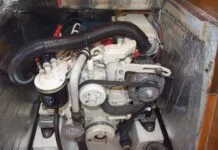Its usually this time of year that fuel contamination rears its ugly head, clogging filters right when we need our engine most. We’ve published several articles on preventing and coping with contaminated diesel fuel-ranging from additives, to fuel-polishing systems, to professional fuel-polishing services-but for some people, none of those remedies will fix the problem, and the only recourse is a thorough tank cleaning. Depending on the size of your fuel tanks, having a professional clean your tank and dispose of the dirty fuel can cost more than $1,000. But, for the careful, competent do-it-yourselfer, there is another option. For those sailors whose tanks have reached the contamination point-of-no-return, here’s a helpful article on DIY tank cleaning that accompanied our July 2009 test of diesel biocides.
There’s no getting around it; once filters begin clogging repeatedly, no additive or treatment applied to the tank will make the solids go away. The only realistic path to a clean tank is manual cleaning. It is commonly assumed this is a job for professionals, or a job that is extremely messy or dirty; that need not be true. Every tank is different; the resources and capabilities of each would-be do-it-yourselfer are different, but the following list of precautions and general guidance should keep you safe and minimize the mess and pain.
Burn the fuel down first. While it is certainly possible to pump all of the fuel out of the tank, a lot of pumping and hauling will be involved. Just like putting off going to the doctor, don’t wait until the problem is fatal. Take your medicine early, burn the fuel out, and clean the tank.
Access. Hopefully the tank is fitted with a sufficient access opening. Although it is certainly possible to add a larger opening to a tank, the safety precautions involved are beyond the scope of this article and a professional should be engaged. Do not simply cut into an empty tank with a saber saw-the heat from cutting can generate enough fumes cause a fire or explosion. Additionally, the access hole must be sealed in a manner compliant with the appropriate code. It may be possible to clean the tank through the existing openings with some ingenuity.
Pumping. Although diesel fuel is not a flammable liquid, flammable mist can be generated by excessive agitation. The use of a shop vacuum is dangerous and has been linked to several fires. The safest pump is a manual bilge diaphragm pump, and most common brands are equipped with nitrile and neoprene elastomers that are compatible with diesel fuel; logically, since fuel and oil in the bilge is not unheard of. Head pumps are also so equipped. Any electrical pump should not be located in a confined space where vapors can accumulate.
Overflows. Be certain a person is stationed at each end of the pumping operation, and that one of these people can stop the pumping. It’s surprisingly easy to lose track of time and overflow the receiving container. If siphon is possible, have a ready means to stop this.
Solvents. Some have suggested wiping down the inside of the tank with solvents in order to remove the last bit of residue. Clearly, this can be an extremely dangerous practice because of the flammable atmosphere the hazardous breathing atmosphere that can be generated. If you plan to wipe down the inside of the tank, a rag moistened with diesel fuel is the safe choice. An aqueous degreaser such Simple Green may also be useful, but it will be necessary to remove all cleaning residue.
Power washing. In many tanks, baffles or limited access openings will make it impossible to reach all portions of the tank. The professional tank cleaners solution is to use a power washer. The accessible portions of the tank will be washed down using an ordinary fan tip, though the end of the lance may be bent somewhat to improve access to the tank roof.
To reach more remote portions of baffled tanks, a tank cleaning nozzle capable of spraying in all directions is used. Several varieties of tank-washing nozzles are available from suppliers such as McMaster Carr. Though only rated at 100 pounds per square inch (psi), a typical power washer does not have the flow to produce over 40 psi pressure. One of the leading manufacturers of tank cleaning nozzles is Lechler, who offer a variety of designs to suit narrow openings.
The nozzle is attached to the end of a short piece of pipe (1-foot by -inch schedule 40 steel is typical); this is critically important to provide stiffness and to prevent the hose from turning back on itself and coming back out of the tank access hole, much like a snake crawling back up the arm of the handler. This stinger is attached to the length of flexible hose (3-10 feet of the same hose that the power washer lance is fed with), which is then attached to the tip of the power-washing lance in place of the usual nozzle. This extension is fed through the baffles in the diesel tank and will reach all areas. The tank cleaning nozzle/stinger is fed by hand and water flow must not be triggered until the nozzle is well inside the tank; a second operator is needed to control the water flow through the lance.
Ideally, the lance should only be triggered when the nozzle is in position and separated from the operator by at least one baffle. The water, sludge, and fuel that is rinsed off will typically drain back to a low area under the access hatch and can be continually pumped out while the powerwashing is in process. Protective equipment during this sort of powerwashing includes heavy rubber gloves, a raincoat, and face shield. Although caution will keep the power washing nozzle in the tank while the water is on, high-pressure water can cause extremely nasty injuries. The following link describes possible hazards using more powerful equipment, but the illustration is valuable.
Disposal. The marinas used oil collection tank should be able to accept the contaminated fuel heel; contamination with polymerization sludge or biological fouling will not present any problems for the used oil recycler. Contamination with gasoline or solvents is not acceptable. For additional information, contact the National Oil Recyclers Association. Oily water is a problem for recyclers, so try to minimize the volume.
Please notice that most of these suggestions focus on safety. Cleaning out a fuel tank is no complicated trick with the proper tools. Doing so safely and efficiently requires thought and preparation.
If you are looking for effective fuel treatments that can prevent future contamination and system corrosion, we have a new eBook available online Marine Fuel Additives. Dealing with everything from ethanol gas treatments to diesel biocides, the book is the first of its kind to separate the true elixirs from the snake oil.




































Thanks for the great tips about using simple green and diesel fuel as cleaners.
What do you think about spray oven cleaner for getting out sticky tarnish from an old gas tank, ie. chevy c-10.
Hello. Thanks for the details tips of tank cleaning. Although the given tips here seems very useful. I am not very keen on the burning the fuel outright. Instead of the outright burning, the fuel can be used for bonfire or some wood burning starter for campsites etc. Anyway, great content here. By telling me how to keep the fuel tank clean, you are also teaching me how it works. Since I have no knowledge about the mechanical parts of vehicles, finding this blog is like a treasure to me.
These maintenance blogs really help people like me out there. I would like to stumble upon more of your works.
I have a 1980 32 Pearson with a diesel motor. The tank had tons of sludge in it. I removed the tank and took it home to clean. An hour into it and not making a lot of progress, I took the tank to a radiator shop and had them soak the tank.
I replaced all the copper tubing to and from the tank with rubber hose, resealed all the fittings, and reinstalled. Should be good for another 40 years provided the fuel condition is monitored.
Not sure what I would have done if I were unable to remove the tank.